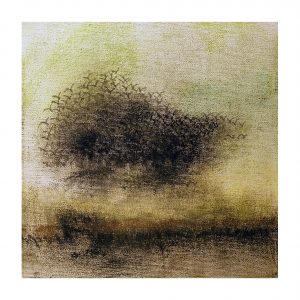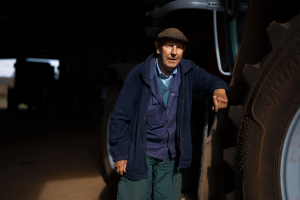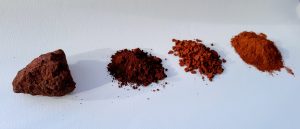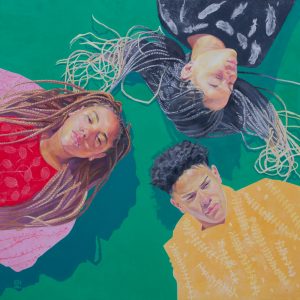Judith Logan
Artist
Meeting the Artist: At Home and in the Boathouse with Judith Logan, One of Antrim’s Quiet Originals, Who Threads Memory, Landscape, and Personal History into Every Layer of Her Work

In a converted barn nestled deep in the Northern Irish countryside, Judith Logan paints with a kind of reverent patience. Her practice is unhurried and deeply rooted – not just in place, but in memory, in weathered textures, and in the long arc of personal experience. It’s no surprise that her work speaks in earthy tones and recurring motifs – swallows, starlings, ochres, and solitary female figures – all reflective of a life that has taken unexpected detours but never lost its creative thread.
Logan is the kind of artist who works with what’s around her. Her home studio – affectionately known as the Black Sheep Gallery – is housed in a restored barn on her property, a space she and her family restored after moving back to Northern Ireland 16 years ago. In the early days, she opened the doors to the public a few days a week, but over time, the demands of family life and caregiving made that rhythm unsustainable. “Family to me comes first,” she says, recounting the years spent caring for her children and family.
Then came COVID, and with it, a new reality. “It’s kind of hard to push my own gallery, to be honest,” she admits. These days, visits to her studio are by appointment only – a choice that preserves both her time and her process. “If people really want to come, we do viewing by appointment and there’s no pressure. They have a wee look around.” It’s a quieter way of working – but one that suits the slow, thoughtful rhythm of her art.
Her voice never wavers between the practical and the poetic. The rural quiet may limit footfall, but it feeds her work in other ways: “It’s a great source of inspiration. It’s peaceful and quiet. Very conducive to making the art.”
Today, Logan splits her time between several galleries: her home studio, the Boathouse Gallery near the Giant’s Causeway – a National Trust rental shared with five other artists – and the Doghouse Gallery in Comber, where she sells her collagraphs alongside the work of jeweller Pamela Crawford. Her art also features in the Yard Gallery in Holywood and with Gallery 545, run by curator Francesca Biondi.
At the Boathouse, she’s had to adapt her approach to suit a tourist-heavy audience – “You’re trying to think of smaller pieces they can take” – but insists on staying true to herself. “I don’t want to be making Giant’s Causeway memorabilia,” she laughs. “You still have to be true to yourself. But at the same time, you have to make sales. That’s every artist’s kind of quandary.”
Material Instincts
Watercolour is Logan’s medium of choice, though she hesitates to commit too narrowly. “I tried all the media,” she explains. “I don’t want to say I’m a multimedia artist – I just work in different media, which is slightly different.”
“There’s a very traditional way of working with it,” she says, “but if you let it do its own thing, it can be really interesting. I love the unpredictable nature of watercolour.” That unpredictability often leads her to take creative risks – washing away layers, building them back up, and allowing accidents to shape the final image. “I’ll do layers and then I’ll actually put it under the tap and remove a lot of paint,” she explains. “Which seems a bit counterproductive, but then you’re left with… it’s like a history of the painting that once was there.”
This embrace of unpredictability runs through much of her work. She’s not afraid to take risks – sewing onto finished paper, for example, adding thread and fabric where it might all fall apart. “It’s a big risk… you can end up destroying the whole piece. But I like the added texture it gives.”
Logan is quick to challenge the boundaries between fine art and craft. “There’s quite a snobbery in the art world about the whole fine art versus craft thing,” she observes. “A lot of our work overlaps. We don’t really know what we are.”
It’s perhaps this openness that drives her continual experimentation. A watercolour might become a drypoint print, then a collagraph – a technique she’s particularly fond of. One started with a discarded painting: “I didn’t like it, so I cut out the shape I did like and transformed the whole piece into a collagraph plate. Sometimes those happy accidents… they’re my favourite pieces.”
She likens her process to cooking. “I make art like I cook – I like to use up my leftovers.” That spirit of resourcefulness and reinvention runs through much of her practice. “If I do a watercolor and I like the composition, I might try a print of that, redo it, change it around, and then maybe try and make a Drypoint,” she explains.
She also integrates locally sourced materials into her work – including natural pigments like red ochre. “The ochre actually, was through Instagram,” she explains. “It’s ocar.ie. She makes her own pigment from red ochre that’s found around the north coast, around the Causeway area.” Using these handmade pigments, Logan brings even more of her surrounding landscape into her practice.
Landscape, Migration, and Memory
There’s a sense of continuity and return in Logan’s work, much like the migratory birds she so often paints. Swallows appear again and again. “I look for them every year when summer’s coming,” she says, describing how they nest under the eaves of her house. “I love swallows. And I love the word in Spanish, golondrina, and hirondelle in French.”
The connection isn’t just aesthetic. Logan lived in Chile for several years, and the sense of being between places lingers. “When I was in Chile, I probably didn’t appreciate it as much as I should have. I was yearning to be back home. And then when we came back to Ireland, I struggled – I wanted to be back in Chile.”
That duality, the longing for elsewhere while being rooted at home, gives her work a reflective, melancholic edge. “In my work you’ll maybe see the theme of ‘faraway fields look green’ quite a lot as well,” she says, pointing to how certain landscapes in her paintings mark moments of homesickness and shifting identity.
“People say my figures look sad,” she notes. “But I don’t think they are. They’re just pensive. I mean, if I painted a woman with lots of smiling teeth, it just wouldn’t look right.”
Those figures – often women, stylised and quiet – are central to her compositions. Are they self-portraits? “Perhaps in some pieces,” she admits, “but it’s not something I consciously consider. When I’ve made the figure, it nearly always reminds me of someone I know.”
From the Studio to the Soil
When she’s not painting, Logan tends to a large vegetable garden beside her home. “Growing something from a seed and watching it grow… it’s kind of an art form in itself,” she says. There’s a rhythm to it, one that mirrors the cycles in her practice: layering, reworking, letting time pass before returning to a piece.
Recently, she’s been exploring new themes. She’s also working on a calendar featuring small original paintings, which she plans to auction. Starlings – “murmurations,” as she calls them – have featured heavily in recent work alongside horses and the circus. “Maybe it’s all reflective of what’s going on in the world right now. I don’t know.”
Meeting the Artist
For all her quiet introspection, Logan values connection – especially in spaces like the Boathouse Gallery, where she sometimes meets buyers in person. “They like to meet the person behind the work,” she says. “It creates a connection.”
To encourage more of that, she’s become involved with County Antrim Open Studios, a grassroots initiative that opens artists’ workspaces to the public.
“We don’t really do craft trails like they do in England. There’s still this idea that galleries are intimidating – too intellectual, or out of people’s price range. This kind of thing helps bring it down to a human level.”
Still, pricing is a constant battle. “I’ve been told to put my prices up and I’ve been told to put them down,” she says. “It’s hard because we just want to make. But you also have to cover your costs. Who decides what something is worth?”
It’s a question with no clear answer, but Judith Logan continues anyway – layering watercolour, thread, and meaning into everything she makes.
She may live quietly, but the work speaks with resonance and depth – part memory, part migration, always returning home.
Keep up with the latest news from Judith via her instagram: judithlogan.art
Find out about the latest exhibitions and explore her shop via her website: judithloganart.com
The Latest Articles

Bob Speers and the Quiet Magic of Ireland’s Bogs
In a room filled with timber, peat, and light, artworks hung on walls are more like fragments of the land itself – weathered, breathing, and alive with memory.

Hernan Farias on Light, Connection and Creative Growth
From the Classroom to the Camera – charting his shift from teaching English in Chile to full-time photography in Northern Ireland.

The Colour & Spirit of Time: Tricia Kelly’s Journey with Ócar
Exploring how sixty million years of volcanic fire, weather, and transformation created the red ochre that now colours Tricia’s life and work.

Faith and Colour: The Genuine Art of Beverley Healy
In her imaginative work, paint becomes prayer – a meditation on trust, surrender, and creation, where colour and stillness meet to form something transcendent.

Ruairi Mooney on Creativity, Practice & the Search for Authentic Art
From the North Coast to the Canvas: a journey of resilience, daily practice, and the slow discovery of an authentic artistic voice.

From Trauma Wards to Ceramics: Denise McAuley’s Authentic Creative Journey
From the trauma wards of the Royal to the shoreline of Cushendall, Denise creates small-batch ceramics that carry memory, resilience, & the rhythms of the sea.




